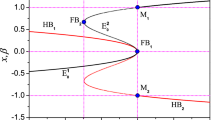Abstract
The traditional geometric singular perturbation theory and the slow–fast analysis method cannot be directly used to explore the mechanism of the relaxation oscillations in the forced dynamical system in which the exciting frequency is far less than the natural frequency. Furthermore, higher codimensional bifurcations may result in more complicated alternations between the large-amplitude oscillations (spiking states, SPs) and small-amplitude oscillations or at rest (quiescent states, QSs) on the trajectories of the bursting oscillations, called also the mixed mode oscillations. For the purpose, here we present a method to explore the mechanism of the bursting oscillations in the excited oscillator. Without loss of generality, we apply the proposed method to explore the dynamics of the normal form of the vector field with codimension-two pitchfork–Hopf bifurcation at the origin. When the slow-varying parametric excitation is introduced, with the increase in exciting amplitude, different types of bursting oscillations can be observed, the mechanism of which can be obtained by employing the overlap of the transformed phase portraits and the equilibrium branches as well as the bifurcations of the generalized autonomous system.

















Similar content being viewed by others
References
Hodgkin, A.L., Huxley, A.F.: A quantitative description of membrane current and its application to conduction and excitation in nerve. J. Physiol. 117, 500–544 (1952)
Kingni, S.T., Nana, B., Ngueuteu, G.S.M., Woafo, P., Danckaert, J.: Bursting oscillations in a 3D system with asymmetrically distributed equilibria: mechanism, electronic implementation and fractional derivation effect. Chaos, Solitons Fract. 71, 29–40 (2015)
Shen, J., Zhou, Z.: Fast-slow dynamics in first-order initial value problems with slowly varying parameters and application to a harvested logistic model. Commun. Nonlinear Sci. Numer. Simul. 19, 2624–2631 (2014)
Desroches, M., Guckenheimer, J., Krauskopf, B., Kuehn, C., Osinga, H.M., Wechselberger, M.: Mixed-mode oscillations with multiple time scales. SIAM Rev. 54, 211–288 (2012)
Rinzel, J., Huguet, G.: Nonlinear dynamics of neuronal excitability, oscillations, and coincidence detection. Commun. Pure Appl. Math. 66, 1464–1494 (2013)
Fenichel, N.: Geometric singular perturbation theory for ordinary differential equations. J. Differ. Equ. 31, 53–98 (1979)
Fraser, S.J.: The steady state and equilibrium approximations: a geometrical picture. J. Chem. Phys. 88, 4732–4738 (1988)
Guckenheimer, J., Harris-Warrick, R., Peck, J., Willms, A.R.: Bifurcation, bursting, and spiking frequency adaptation. J. Comput. Neurosci. 4, 257–277 (1997)
Wang, C., Zhang, X.: Canards, heteroclinic and homoclinic orbits for a slow-fast predator-prey model of generalized Holling type III. J. Differ. Equ. 65, 3397–3441 (2019)
Ai, S., Sadhu, S.: The entry-exit theorem and relaxation oscillations in slow-fast planar systems. J. Differ. Equ. 268, 7220–7249 (2020)
Aggarwal, M., Cogan, N., Bertram, R.: Where to look and how to look: combining global sensitivity analysis with fast/slow analysis to study multi-timescale oscillations. Math. Biosci. 314, 1–12 (2019)
Guckenheimer, J., Kuehn, C.: Computing slow manifold of a saddle type. SIAM J. Appl. Dyn. Syst. 8, 854–879 (2009)
Zhang, Z.D., Li, Y.Y., Bi, Q.S.: Routes to bursting in a periodically driven oscillator. Phys. Lett. A 377, 975–980 (2013)
Teka, W., Tabak, J., Bertram, R.: The relationship between two fast/slow analysis techniques for bursting oscillations. Chaos Interdiscip. J. Nonlinear Sci. 22, 043117 (2012)
Izhikevich, Eugene M.: Neural excitability, spiking and bursting. Int. J. Bifur. Chaos 10, 1171–1266 (2000)
Chen, X.K., Li, S.L., Zhang, Z.D., Bi, Q.S.: Relaxation oscillations induced by an order gap between exciting frequency and natural frequency. Sci. China 60, 289–298 (2017)
Bi, Q.S., Li, S.L., Kurths, J., Zhang, Z.D.: The mechanism of bursting oscillations with different codimensional bifurcations and nonlinear structures. Nonlinear Dyn. 85, 1–13 (2016)
Wang, X., Li, W., Wu, Y.: Novel results for a class of singular perturbed slow-fast system. Appl. Math. Comput. 225, 795–806 (2013)
Li, X.H., Bi, Q.S.: Cusp bursting and slow-fast analysis with two slow parameters in photosensitive Belousov–Zhabotinsky reaction. Chin. Phys. Lett. 30, 070503 (2013)
Bi, Q.S., Ma, R., Zhang, Z.D.: Bifurcation mechanism of the bursting oscillations in periodically excited dynamical system with two time scales. Nonlinear Dyn. 79, 101–110 (2015)
Dijkstra, K., van Gils, S.A., Janssens, S.G., Kuznetsov, YuA: Pitchfork–Hopf bifurcations in 1D neural field models with transmission delays. Phys. D-Nonlinear Phenom. 297, 88–101 (2015)
Sanders, J.A.: Normal form theory and spectral sequences. J. Differ. Equ. 192, 536–552 (2003)
Kuznetsov, YuA: Elements of applied bifurcation theory. Appl. Math. Sci. 288, 715–730 (2004)
Wiggins, S.: Introduction to Applied Nonlinear Dynamical Systems and Chaos. Springer, New York (2003)
Author information
Authors and Affiliations
Corresponding author
Ethics declarations
Conflict of interest
The authors declare that they have no conflict of interest.
Additional information
Publisher's Note
Springer Nature remains neutral with regard to jurisdictional claims in published maps and institutional affiliations.
Appendix
Appendix
Rights and permissions
About this article
Cite this article
Xia, Y., Zhang, Z. & Bi, Q. Relaxation oscillations and the mechanism in a periodically excited vector field with pitchfork–Hopf bifurcation. Nonlinear Dyn 101, 37–51 (2020). https://doi.org/10.1007/s11071-020-05795-0
Received:
Accepted:
Published:
Issue Date:
DOI: https://doi.org/10.1007/s11071-020-05795-0




